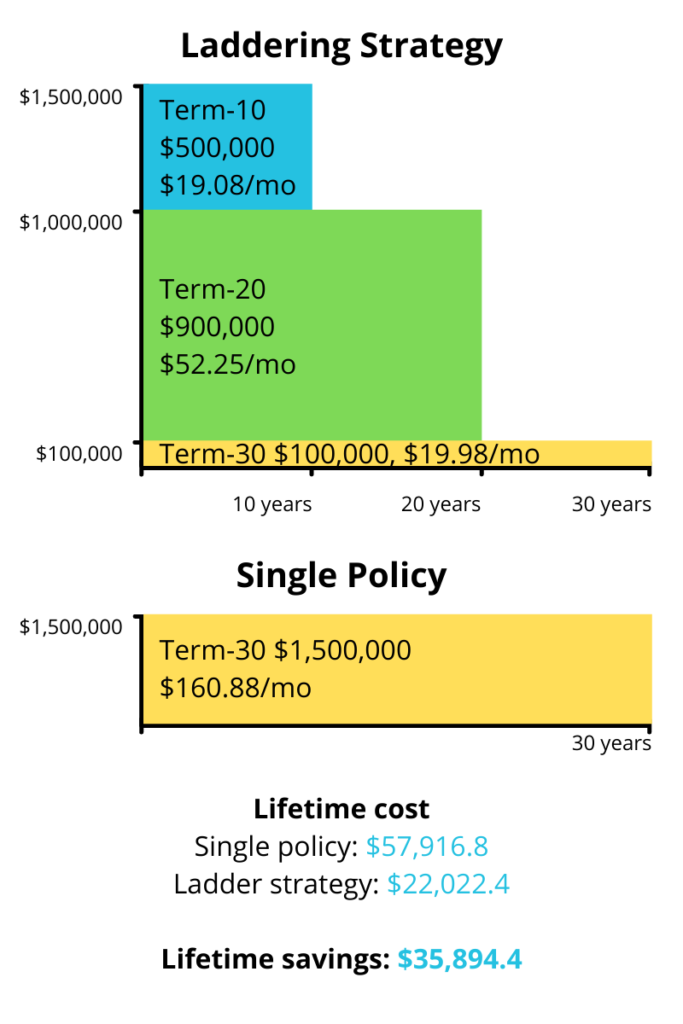Table of contents
What is the life insurance laddering strategy?
No, you don’t build an actual ladder with life insurance. (How would that work anyway?)
Instead, you buy term insurance of different lengths (term-10, term-20, etc) at the same time so that your coverage is staggered.
This ensures that you pay only for the coverage you need while saving money in the process. It could end up saving you over $10,000!
Read on to find out how this strategy works.

The Traditional Way to Buy Life Insurance
When you use a life insurance calculator to determine how much coverage to buy, it gives you a single number. The output is based on variables like your income, mortgage balance, children’s education funds, and more.
Let’s use a simple example to illustrate what the calculator might compute. You’re currently 35 and need life insurance to:
- Pay off a $450,000 mortgage
- Pay $50,000 into education funds for your 2 children
- Replace your $50,000 income until your youngest child turns 25, which is 20 years = $1,000,000
The total amount of insurance will be $1,500,000.
But this number is just a snapshot of how much life insurance you need now. But it doesn’t take into account changes that will affect your life insurance needs in the future.
Let’s say you take out a $1,500,000 term-30 policy to cover you until 65.
Fast forward 10 years and your financial situation has changed. You still need life insurance to:
- Pay off a $375,000 mortgage
- Pay $25,000 for education funds
- Replace your $60,000 income for 10 years = $600,000
Now your life insurance needs have reduced to $1,000,000. That $1,500,000 term-30 policy now overinsures you.
Fast forward another 10 years and now you only have a $100,000 mortgage remaining. You’ve completely funded the education funds. You also don’t have any more income replacement needs since your youngest child is now 25 and independent.
Your total life insurance need is only $100,000. That $1,500,000 term-30 policy now definitely makes you overinsured.
What you could’ve done from the beginning is ladder your term insurance.
How Does Laddering Life Insurance Work?
Your life insurance needs are the highest while you’re young and have the most financial obligations. As you grow older, increase your savings, and pay off debt, your life insurance needs decrease.
By anticipating this decrease, you build a package of term policies of different lengths. This is called life insurance laddering. You’ll also hear it referred as layering or stacking.
Using the example above, you can stack term-10, term-20, and term-30 on top of each other, creating a life insurance ladder.
From years 1-10, you need $1,500,000. This decreases to $1,000,000 from years 11-20 and to $100,000 from years 21-30.
To create the ladder, you can buy $100,000 term-30, $900,000 term-20, and $500,000 term-10.
Because all the coverages are under the same policy, you only have to pay one policy fee. Plus, you save by buying in bulk from one insurance company.
Here’s what it looks like and how much it costs:

In this example, using the laddering strategy saves you 62% or $35,894.4!
Now, not everyone will experience the same savings. It depends on your gender, age, smoking status, and health status. And of course, the amount you choose for each term plays the biggest role in how much you can save.
But the general idea is that you will save a lot of money by laddering life insurance all the while being properly insured.
Now that’s a win-win situation.
But it’s not all rosy with the laddering strategy. Let’s take a look at the drawbacks of laddering next.
Drawbacks of Laddering Life Insurance
Less coverage
One of the downsides of laddering that you can see right away is that you’re getting a lot less coverage compared to buying a single policy.
At the same time, inflation will decrease the purchasing power over time. That $100,000 from years 21-30 won’t have the same purchasing power as $100,000 now.
If you don’t feel like that’s going to be enough coverage, you can always buy more at that time. But keep in mind you will be much older and insurance will cost much more.
It will also be harder for you to qualify for coverage if your health has declined over the years. It’s always a good idea to buy insurance while you’re young and healthy.
Hard to calculate future needs
Predicting how much insurance you need in 10, 20, and 30 years is no easy task. Sometimes, it’s difficult enough to calculate how much insurance you need now.
Your financial and personal situation is constantly changing. Here are some financial changes that can affect your insurance needs:
- Selling your home
- Refinancing your mortgage
- Taking out a line of credit
- Getting a raise
- Losing your job
And here are some changes in your personal life that can impact your insurance needs:
- Having more children
- Getting a divorce
- Death of a loved one
These major life events can either increase or decrease your life insurance needs.
You might think your life is stable now and you can accurately predict your insurance needs 10 to 30 years into the future. But chances are, one or more of these things will happen which will throw a wrench into your plans.
More difficult to understand and manage
To implement the life insurance laddering strategy, you need to buy a base policy and term riders.
In the example, you would buy a term-30 policy and add term-20 and term-10 riders.
Some people may find having different terms and different coverage amounts for each term confusing.
Then you have to manage the policy so that the term riders don’t renew beyond their initial terms. Most people prefer to keep things simple so the added work is certainly not welcome.
Besides our example, there are lots of other ways to ladder life insurance:
- Term-10 and term-20
- Term-20 and term-30
- Term-10 and term-30
- Term-10, term-20, term-30, whole life
- Term-10, term-20, term-65
- Term-20, universal life
And much more. In fact, the combinations are nearly limitless. Each variation of laddering requires a deep understanding of the product and strategy. The more layers of insurance you have, the more complex and the harder it is to manage.
Who is Laddering Life Insurance For?
By now, you should know if you should use the laddering strategy. Here is the typical profile of someone who is a good candidate:
- Steady career and stable income
- Stable family life
- Have a mortgage or other debt
- Predictable financial situation
- Easy to picture life in 10, 20, and 30 years, and until age 65
Because of the savings compared to a single policy, you’d want to use this strategy if your budget is tight.
The vast majority of people don’t fit this profile and would be better off buying a single policy.
How to implement?
If you want to go ahead and implement this strategy, follow these steps:
1. Get a list of insurance companies that offer the terms that you need. Not every company has term-30 so if you want that in your ladder, you’ll need to filter your list.
2. Find the company that provides the best price. Some might have lower term-10 but higher term-30 costs. You’ll want the package with the lowest overall cost.
3. Apply for the coverage. An insurance agent can guide you through the steps from application to underwriting.
As licensed life insurance advisors, we can help you through the steps. We’ll help you find the right ladder and the right insurer to implement the strategy.
Now It's Your Turn
Is laddering life insurance strategy right for you? Or do you prefer a single policy?
Let us know in the comments below.
Give us a call today at 604-928-1628 or email us at info@briansoinsurance.com for a free, customized quote. Or quote for yourself and instantly compare all the insurance companies in Canada here.
While we make every effort to keep our site updated, please be aware that timely information on this page, such as quote estimates, or pertinent details about companies, may only be accurate as of its last edit day. Brian So Insurance and its representatives do not give legal or tax advice. Please consult your own legal or tax adviser. This post is a brief summary for indicative purposes only. It does not include all terms, conditions, limitations, exclusions, and other provisions of the policies described, some of which may be material to the policy selection. Please refer to the actual policy documents for complete details which can be provided upon request. In case of any discrepancy, the language in the actual policy documents will prevail. A.M. Best financial strength ratings displayed are not a warranty of a company’s financial strength and ability to meet its obligations to policyholders.

3 Comments
[…] the surface, while a single term insurance policy may be seem like a perfect fit, combining and layering different policies could be more appropriate and save you more money in the long term. This is where the prevalence of […]
It looks like layering life insurance is a good idea. I like the idea of only paying one policy fee instead of multiple. I haven’t looked at life insurance yet, but I will definitely keep this in mind!
Hi to every body, it’s my first visit of this web site; this
webpage includes awesome and genuinely good stuff in support of
visitors.